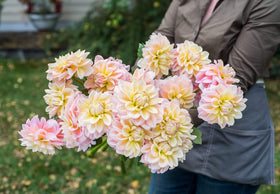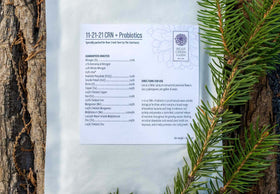Rain is a gardener’s friend, but too much of it can turn an ally into an adversary. While droughts often capture our concern, the effects of excessive rain can be equally devastating, though less frequently discussed. Here’s how to recognize and address the aftermath of heavy downpours, ensuring your garden remains vibrant and resilient.
The Impact of Excessive Rain
-
Waterlogged Soil and Root Damage
- Immediate Effects: Soggy soil deprives roots of oxygen, leading to rot and plant decline. Some plants, like lavender, carnations, lamb's ear and artemisia, can die within days of sitting in waterlogged soil.
- Long-term Effects: Even more adaptable plants, such as daylilies and irises, can suffer partial root rot, making them vulnerable to future stress from heat, cold, or drought.
- Remedies: Avoid compacting wet soil by staying off it as much as possible after rains. Remove excess mulch to let the soil dry out and then ensure it isn't more than 2"- 3" thick for ensuing dry spells.
-
Fungal Diseases
- Immediate Effects: Fungal spores thrive in humid conditions, causing leaf spots, streaking, and browning.
- Long-term Effects: While most plants grow through leaf diseases, affected foliage can drop prematurely. Severe infections might require fungicides but give the plants time to recuperate before making this decision.
- Remedies: Remove and dispose of diseased leaves to prevent future outbreaks. Do not put diseased leaves in compost pile.
-
Molds and Mushrooms
- Immediate Effects: Wet lawns and mulched beds can harbor slime molds and various mushrooms.
- Long-term Effects: Though often harmless, some mushrooms can be poisonous. Slime molds, while unsightly, do not harm plants or pets.
- Remedies: Rake away slime molds if they bother you. Remove any suspicious mushrooms, especially if you have children or pets.
-
Nutrient Deficiency and Yellowing Leaves
- Immediate Effects: Excessive rain can wash away soil nutrients, leading to yellow or discolored leaves.
- Long-term Effects: Nutrient deficiencies can stunt plant growth.
- Remedies: If green color does not return after waiting some time, consider a balanced fertilizer, containing nitrogen, to help plants regain their vibrancy.
-
Leaning Trees and Erosion
- Immediate Effects: Saturated soil may cause trees to lean, posing a risk of falling.
- Long-term Effects: Erosion can expose roots, leading to further instability and potential tree loss.
- Remedies: Contact a professional arborist for large, leaning trees. For smaller trees, stake them back upright. Recover and redistribute any eroded soil to cover exposed roots and stabilize the area.
Post-Rain Actions for Garden Recovery
-
Drainage Improvements
- Observation: Identify areas where water pools and amend with additional soil to level out depressions.
- Solution: Install drain pipes or swales to redirect water flow. Consider creating rain gardens to capture and manage runoff attractively and effectively.
-
Erosion Control
- Observation: Check for relocated soil or mulch and restore it to its original location, ensuring it doesn’t pile against plant stems or trunks.
- Solution: Use stones or splash blocks at the base of downspouts to diffuse water flow and prevent soil displacement.
-
Plant Selection and Soil Care
- Observation: Note which plants struggled in wet conditions and consider replacing them with more tolerant varieties for future years if rainier climate is anticipated.
- Solution: Prepare garden beds with improved drainage for future plantings. Raised beds and soil amendments can make a significant difference in preventing waterlogging.
Learning from the Rains
Every heavy rain provides valuable insights into your garden’s vulnerabilities and strengths. By taking proactive measures and making informed adjustments, you can transform challenges into opportunities for a healthier, more resilient garden. Embrace the lessons of excessive rain to cultivate a thriving, well-adapted landscape that endures both the deluge and the drought.




